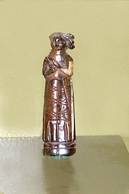Archaeological works
Accidental discoveries of palaeontological and archaeological relics in the area of Cieszyn and the vicinities have, for a long time, aroused the interest of local lovers of antiquity. The earliest findings, known to us from history, and attempts to describe them, come from the turn of the 18th century. They are connected with the activity of the founder of the first Cieszyn Museum, Rev. Leopold Szersznik, an unwearied pursuer of broadly understood science. Reverend Szersznik not only collected and described traces of the past found in the earth, but also (as it appears from his notes) penetrated excavations conducted in the town area, finding the relics of primaeval and mediaeval vessels or bones and teeth of mammoths. The first organized archaeological examinations were conducted in Cieszyn in 1934.Their purpose was to investigate the vaults of the old Dominican church (the present parish church). During the work, under the floor of the church, several tombs with the burial remains of town inhabitants of rank were discovered. One of the most interesting discoveries was that of a large tomb, under the floor in the presbytery, and the remains of a Swedish aristocrat, Sigrit Brahe, who was related to the royal family of the Vasa dynasty. In the late 1960’s an archaeological section of the Association of Admirers of the Region came into being and it devoted itself, with great enthusiasm, to investigations in the vaults of old Cieszyn. Finding not only underground structures not known before but also supplying a number of relics from the time of the mediaeval town. One of the most interesting was the discovery, in the area of Szersznika street, of rectangular excavations lined with wooden walls, with a rich agglomeration of mediaeval articles. The archaeological examinations conducted in this area in the 1980’s proved the existence of a few objects of that type. These discoveries prove the spatial development of the town in the Middle Ages. The most important examinations were the ones whose aim was to find out the course of the mediaeval town walls. In 1980, in a few excavation sites that were established, well-preserved low fragments of stone defensive walls, 2 meters wide, were located. The walls that surrounded the town had three main gates. The stone relics of one of them, the so-called Frysztacka Gate that enclosed, from the northern side, today’s Zamkowa street, were found during earthworks conducted in the process of building the heating network in 1998. An interesting discovery was also made recently in the northern part of the present Market Square. During the earthworks conducted to provide waterworks installations a fragment of a spherical stone object, 5 metres in diameter, was discovered. The object, in connection with ceramic material and the remains of footwear can be dated from the 15th century. What its function was and how one can connect its existence with the existence of the Market Square in that place is still to be explained. During the mentioned works a layer of paving-stones at the level of the older Market Square was also discovered. The discovery of a beautiful little bone figure of a woman, found in 2000 in a shallow mediaeval layer in Fredry street (i. e. the part of the town where most surely the beginnings of Cieszyn should be looked for), provides a stimulus to undertake bigger archaeological works that make it possible to get to know about the oldest history. One can add minor discoveries, e. g. of town wells or remains of the old waterworks, to the group of more important archaeological discoveries presented here and connected with getting to know the old past of the town.
W. Kuś, translation L. Krzanowska & J. Whitewood















